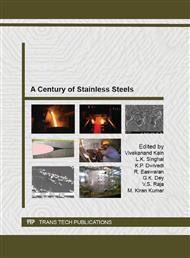p.606
p.618
p.626
p.632
p.645
p.670
p.681
p.691
p.697
Use of Advanced Austenitic and Duplex Stainless Steels for Applications in Oil & Gas and Process Industry
Abstract:
Stainless steels are widely used in the Oil & Gas and chemical process industry. This group of materials is today available in a large variety of alloy compositions, and practically all product forms needed for a construction are available. A historical view and application examples are given on the stainless steel evolution, from the standard grades used in chemical processes to todays most advanced applications in the chemical and oil & gas industry, where demands on reliable and long lasting solutions are necessary. The influence of alloying elements on the properties and manufacturability is described. The chemical industry is a very wide definition of a large group of industries with very different products, from plastics and organic acids to fertilizers, drugs and pesticides. Applications of stainless steels within the chemical industry are described. The first example is organic acids, where the use of high alloyed duplex stainless steels such as UNS S32205 and UNS S32750 have been successful. Another example is phosphoric acid applications, where the aggressiveness of the process solution depends very much on the fluoride and chloride content of the rock phosphate. In sulfuric acid, the material of construction is very much dependent on the acid concentration and temperature. Nitric acid is another common fertilizer acid which is highly oxidizing, and thereby demands stainless steels with high chromium content but with low molybdenum contents. The Oil & Gas industry uses very high quantities of carbon steel and stainless steel in their constructions. The oil wells are defined as sweet when the well contains carbon dioxide and no substantial amounts of hydrogen sulfide, when there is hydrogen sulfide present in the well, the wells are defined as sour. An overview on materials depending on the application is given. In subsea applications, hydraulic control lines (umbilicals) are used for control of valves and for methanol injection in subsea platforms. UNS S32750 is a high strength duplex stainless steel which today is the first choice for umbilicals and has been chosen for a very large amount of umbilical projects worldwide. The newly developed hyper duplex stainless steels with a combination of even higher corrosion resistance and strength are introduced for applications in oil-gas industry. The possibilities with stainless steels are endless, and new alloys are constantly being developed to meet industrial challenges of today and in the future. By choosing the right stainless steel grade, it is possible to find a solution to almost all challenges in the Oil & Gas and Process industry.
Info:
Periodical:
Pages:
645-669
Citation:
Online since:
September 2013
Authors:
Price:
Сopyright:
© 2013 Trans Tech Publications Ltd. All Rights Reserved
Share:
Citation:


